As we get older performing tasks of everyday living can become challenging. This includes bathing and showering. Luckily, a wide variety of bath aids are available to help you maintain your independence and bathe comfortably and safely. In this article, we will describe some of the most necessary and popular aids for bathing and showering. Read on to learn more.
12 small purchases that can make a big difference
You may not need large, expensive or complicated assistance items. Have a talk with your occupational therapist (OT). You may find that the problems you’ve been having getting in and out of the bath can be easily and affordably resolved.
A number of simple accessories are available to help you easily and affordably make your bathroom more comfortable and accessible.
Here are a dozen of our top recommendations:
1. Nonslip mats for the bathroom floor and the floor of the tub can really help you avoid sudden falls.
2. Removable grab bars attach with very strong suction cups. These are intended for occasional or travel use rather than daily use.
Portable Support Safety Grip Grab Handle with Suction Cup Fitting
3. Another inexpensive fix that adds a great deal of independence to your shower or bath experience is shower controls. Thermostatic controls help prevent accidentally chilling or burning yourself.
4. A bath cushion can help support your back or your neck.
5. Replacing your old faucet handles with easy access handles is of tremendous help to people with arthritis. Alternately, tap turners can be added to your existing faucet handles to make it easier to turn them off and on.
6. A body dryer can make it easier to dry your body with warm air without having to maneuver a towel.
7. If you have low sensation, a bath thermometer can help ensure that your bathwater is a safe temperature.
8. A water level alarm and/or a special plug can help prevent bathwater overflow.
9. Sponges and brushes equipped with long handles can make washing your back much easier.
10. An automatic soap dispenser attached to the wall can make it easier to get just the right amount of soap. This saves you money and also saves you the potential of slipping on a dropped soap bar.
11. If you’re able to step over the side of the tub but feel a little bit unsteady, a sturdy, properly installed bath rail coupled with a nonslip mat or set of nonslip bath steps can help make this move easier for you. You can also have the floor of your tub or shower treated to become nonslip, add nonslip adhesive strips.
Drive DeVilbiss Healthcare Portable / Stackable Padded Bath Step
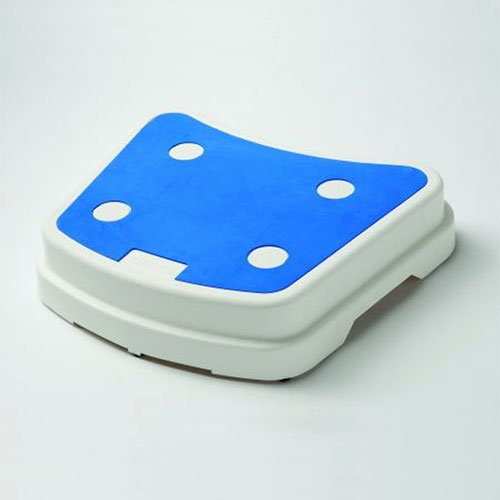
12. Another nice touch to help keep the bathroom slip-free is an extractor fan. This helps reduce the collection of steam on surfaces. Naturally, dry surfaces are far less slippery than wet ones.
Permanently installed grab rails provide support & safety
Adding a few handrails to help steady yourself can help you enjoy your bath or shower without fear of slipping or falling. When installing bath rails, it’s important to be sure that you get genuine grab rails and that they are properly installed. Good grab rails can help support all of your weight and give you a firm anchor when you need to enter or exit or move from one place to another in the bath.
Safety Rail Grab Bar Support
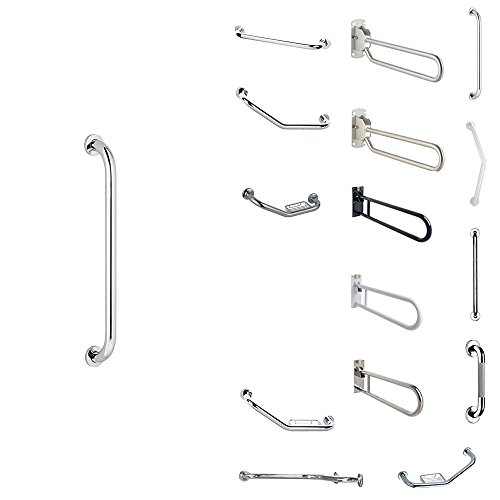
There are lots of different types available. Some are straight; some are angled, and there are also choices between smooth and grippy texture. Consult closely with your OT to determine exactly which type will work best for you. If none of the ready-made options are workable, you may be able to have some made especially for you.
Independence at bath time using a bath board or seat
Getting in and out of the tub can be difficult, but if you really enjoy a good soak changing to showering daily can be quite disappointing. Having grab bars installed and making good use of nonslip flooring can help you continue enjoying your bath, but if you need more help, there are lots of other options.
If you are the only person using your bath or shower, you may want to have a built in seat installed to make it easier to get in and out of the tub or to be more comfortable while showering. There are also very sturdy portable versions available for people who share a bathroom. You can have your bath seat or board put in place before you plan to shower or bathe and then easily remove it before the next person showers or bathes.
Suspended Bath Seat
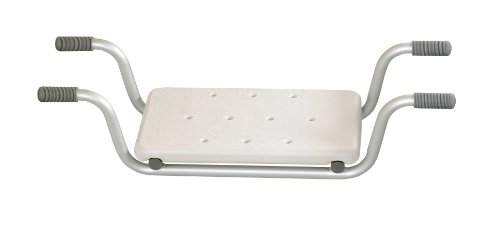
Your occupational therapist can help you choose between a bath board or a shower seat. If you are able to step in and out of the tub without much problem but unable to stand for a long period of time while showering, or if you are unable to rise from the tub, a shower seat can be helpful. You can step over the rim of the tub and then sit on the shower seat while you shower or lift water from the tub to bathe yourself.
Round Bath or Shower Seat
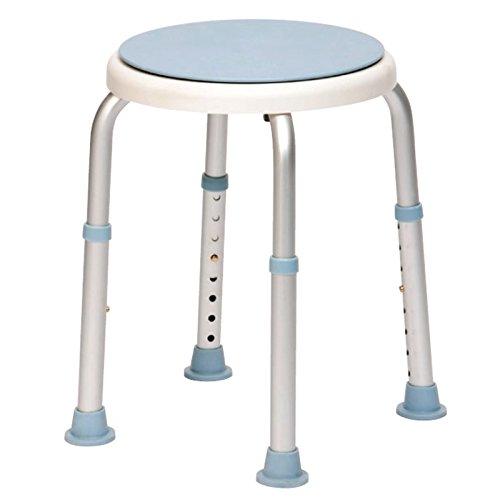
If you’re not able to step over the rim of the tub, a bath board can be helpful. It spans the entire width of the tub and extends over the side so that you can sit and then swing your legs into the tub. Some have swivel seats to help make this maneuver a little bit easier.
Swivel Bather

When you use either of these devices, you are not intended to sit down into the tub to take a luxurious bath. These devices are intended to help you enter and exit the tub easily and bathe or shower without fatigue.
Naturally before you purchase a bath board or shower chair, you should carefully measure your tub or shower stall to be sure that the model you have in mind will fit. You must also make certain that the rim of your tub is wide enough to ensure that your bath board will be securely attached to avoid slipping and falling.
Bath boards come in a variety of materials. You can choose from very heavy duty plastic or resin, metal or wood. Most people find the plastic or resin more comfortable for seating as it does not tend to be as cold or quite as hard. Many people like to lay a towel or memory foam bath mat over the seat for greater comfort.
It’s a good idea to purchase a model that either has drainage holes or slats or is slightly tilted to allow excess water to run off. Also, be sure to double check the weight capacity of the bath chair or board you plan to purchase.
Lifts & hoists give you added mobility
If you do not have the strength or mobility to step into the tub or if you are non-ambulatory, a lift or a hoist can be extremely helpful. Bath lifts work by scooping you up from underneath. Bath hoists raise you from above.
This type of mechanical bath aid can be rather costly, but they’re generally quite a bit less expensive than remodeling your entire bathroom. Be sure to talk with your OT and consult organizations such as the Disabled Living Foundation to determine fair pricing and possible assistance.
Just as with any other type of bath aid, you’ll need to take good measurements and determine the strength and stability of your existing shower stall or bath before purchasing a bath hoist or lift. When compared with a bath board or bath seat, a bath lift has the advantage of being able to lower you into the water.
Lifts
Removable, motor driven bath lifts are made of very strong plastic. You affix this type of seat to the tub using very powerful suction cups. The device should span the entire width of the tub. Read our review of Bellavita Bath Lift.
Bellavita Bath Lift

You would use the device in a manner very similar to a bath board. First, sit on the edge of the device, lift your legs over the side of the tub and then slide to the center. From here, you could operate the seat using a waterproof handset. This would allow you to lower yourself into the water take your bath and raise yourself out again.
Some of these devices are backless and some have backs. If you are not able to support yourself in a seated position, naturally you would want a lift that has a back. These lifts are generally powered using rechargeable batteries that can hold a charge for a couple of hours.
There are number of clever variations on the bath lift concept. Among them are:
1. A hydraulic lift works in a similar manner to an electric motor driven lift. The difference is you need to have quite a bit of upper body physical strength and power to be able to operate this type of lift independently. This might be a good choice for a young, fit paraplegic.
2. An inflatable cushion device which you inflate with an electric pump. You seat yourself on the device and then deflate it to lower yourself into the water. When you finish your bath, you use the pump to reinflate the seat and raise yourself to the rim level of the tub so you can exit.
Inflatable Bath Chair
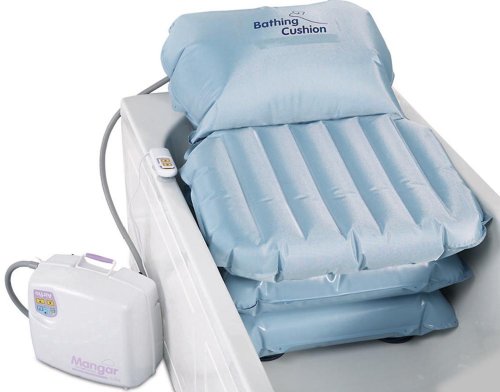
3. Motorised, fixed band lifts consist of a wide, strong fabric band that is attached to a roller on the wall side of the bath and to the floor on the outside of the bath. The band stretches across the bath, and you sit on it and then press a button to lower yourself into the tub. When you’ve done with your bath, you press another button and raise yourself out. This type of lift does not have a back support.
Mobility Bath Lift
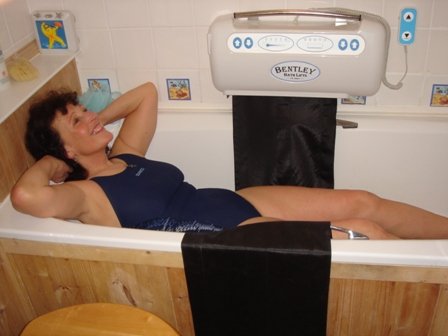
Hoists
Like bath lifts, hoists can also be manually operated or motor driven. Hoists may be anchored to a pole fixed in the floor, or they may be attached to the ceiling. Either way, the idea is that if you have very limited mobility, you can have an assistant help you into the hoist which would then raise you over the side of the tub and lower you into the bath.
There are mobile versions of hoists available so that you can use the device to get in and out of the tub and also to get in and out of bed. It is also helpful for transferring from wheelchair to easy chair. For quadriplegics, having a hoist can be very helpful to attendants and can reduce the possibility of attendant injuries during transfers.
Adapting your bathroom
If you don’t like the idea of having a lot of medical looking equipment in your bathroom you can simply do a bathroom makeover that leaves the room quite chic and attractive and also accessible and functional for you. Talk with specialists at the Center for Accessible Environments (CAE) for good ideas and practical advice.
This is a project that you can undertake long before you really need an adaptive bath. These types of improvements can make your bathroom more attractive and easier to use for everyone. Get in touch with a bathroom fitting specialist to help you decide whether you would prefer a walk-in (or roll in) shower or bath or a wet room.
Walk-in baths
If you love a good bath, you’re sure to be very happy with a walk-in bath. This type of tub has a door in the side so that you can simply walk in, close the door and run the water.
One disadvantage is that you must get into the empty tub and then sit and wait until it is filled with warm water. When you’re done bathing, you must wait until the water has drained out before you open the door.
This means you’ll need to be able to warm your bathroom quite effectively. Installing hooks close at hand is also a good idea so that you can keep your terrycloth robe and bath towels within easy reach.
Built-in seat baths
You can have a tub built-in that has a seat preinstalled. These types of seats are better looking, sturdier and more comfortable than the add-on sort. They can be very unobtrusive and can support very heavy bathers.
Shallow tub
One very discreet way of making your tub more accessible is simply to replace it with a shallower tub. If you’re not bothered by a shallow bath, installing one of these low-rise tubs along with some good handgrips and slip resistant flooring can be a good solution.
Wheelchair or walker accessible showers
If you’re happy with showering, you may be able to meet your accessibility needs by installing an easy-access shower. Some shower stalls are walk-in with just a slight step in, others are roll in with no step. For complete shower accessibility, you might consider making your entire bathroom a wet room or setting aside a “wet floor” section of the room.
When you do this, the entire area is tiled or covered with waterproof, non-slip flooring, a drain is installed and the showerhead is affixed to the wall. There’s no need for any step up.
If you have trouble standing for an extended period of time, you can have a shower seat built into your wet floor space or your shower cubicle. Some showers have seats that are made of sturdy resin material and can support a great deal of weight.
You may also get a drop-down seat that is affixed to the wall, or you can use a shower chair. Be sure to have grab rails in place to help you when sitting and rising.
Non-slip flooring is essential
It’s best to have your entire bathroom floor replaced with safety flooring. This type of flooring is made of vinyl or rubber and has a rough substance such as silicon carbide, aluminum oxide or quartz crystals incorporated to prevent slipping.
Where & how can you get bath aids?
You can always look up different types of mobility and bath aids online to get an idea of what’s available. You can also visit a Disabled Living Center (DLC) or mobility shop to see the equipment and choices in person. You may even be able to try them out.
Adaptive equipment is usually rather pricey, but financial assistance may be available through your health scheme or other providers. Your occupational therapist should be able to guide you in finding assistance that will work for you.
Specialist adaptations to your home can also be quite costly, but if you have a disability, chronic illness or age-related limitations you may be eligible to receive a grant (i.e. the Disabled Facilities Grant). Talk with the environmental health department or your local social services office to find out.
Frequently Asked Questions
Q: How to give a sponge bath to an elderly person?
Gather all supplies and put them by the bed. These include two buckets of warm water (46C or less but not cold), body wash or a bar of soap, washcloths and a stack of clean towels.
For the soap, use soap or body wash that is easy to rinse away. Remember you don’t have the luxury of rinsing them under a shower. Avoid any soap that leaves residues as that could cause irritation. Consider buying no-rinse body wash.
Place two towels under the elderly person to keep the mattress from getting wet and use another towel or a sheet to cover them.
Help them take off their clothes.
Working your way from their face to their legs, first apply soap on a part of their body and scrub gently with a washcloth.
Dip another washcloth in the rinsing bucket and wipe away the soap. As soon as you finish washing one part of the body, cover it to keep them warm.
Midway through the bath (perhaps, when you finish cleaning the torso), replace the water in the buckets with clean water.
Remember to be careful when cleaning their back. Lift them onto their side gently.
When you finish, apply moisturizing lotion and help them dress in clean clothes.
Q: How to get out of bath without aid?
Several types of bath aids that can help an elderly person get out of a bath on their own. Examples include a grab handle (suction or permanent), a bath step and a swivel bather.
Q: Where to buy handicap bath aids?
You can get a wide variety of bath aids on Amazon and other online retail sites. Many supermarkets may also have in stock a few bath aids.
For the best variety and prices, look for stores that specialise in independent living products. The best example is NRS Healthcare. Others include UKS Mobility, Essential Aids and Manage At Home.
